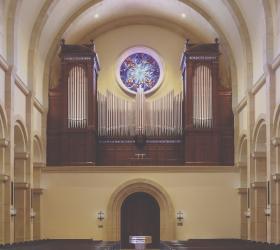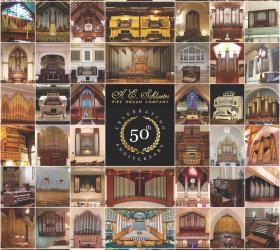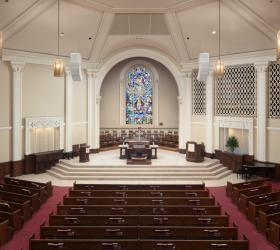
Cover
Aeolian-Skinner opus 1015 (1940), restored 2001 by
Thomas-Pierce, Inc., Palm Beach, Florida
Music room of Thomas R. Thomas and J. Steven McCall, West
Palm Beach, Florida
The first Harrison Skinner installed in Washington, D.C.,
forgotten and silent for many years, sings forth again in a new and vibrant
setting. Aeolian-Skinner opus 1015 was built for the Calvary Methodist Church
located in the Meridian Hill section of Washington. Once a very affluent
community, the many facilities of the church included a bowling alley and
gymnasium. G. Donald Harrison went to Washington August 6, 1940 to meet with
the organist Louis Potter, take measurements and sketch the physical
arrangement of the instrument. The existing organ at the time of Harrison's
visit was a 1917 Austin opus 697, two manuals and 20 stops.
Several sketches of a proposed façade for the chancel
of Calvary and the stop-list of the Austin in Harrison's handwriting appear in
the Skinner files. The Skinner Company allowed the church a credit of 900
dollars for the Austin organ and also removed the instrument for them. Chimes
from the old organ were used in the Skinner with new actions.
The Austin was installed in a deep chamber on the left side
of the chancel with only an opening facing across. Mr. Harrison's preliminary
sketches proposed that another opening be made to face the congregation,
possibly having duplicate sets of shades on the swell and choir boxes. However,
the new organ was installed in basically the same chamber with only an opening
facing the chancel and no façade.
The organ departed somewhat from Harrison's usual
specification of the period due to the influence of Louis Potter, and also
reflects the work of E.M. Skinner. Scales are very generous; the Great first
open is a Diapason, not a Principal. The major Swell reed contains English
shallots and there are three celestes. However, the Choir adheres to the
Harrison concept of the American Classic. All the manual divisions of the
instrument have 73-note chests and the Choir and Great pipework material is
Skinner's frosted tin.
We learned of the availability of the organ in the spring of
1996 and Hugh Pierce and I made a trip to Washington to inspect it. What we
found was horrifying and, I must admit, intimidating. Only the Great and part
of the Swell were winded, and for all practical purposes the organ was
unplayable due to considerable water damage. Most of the damage was confined to
the reservoirs and pneumatic switching. Thankfully, the pipework and most of
the chests were in excellent shape and that encouraged us to pursue
negotiations to purchase the organ. The layout was unique and creative, as
there were 33 ranks in a very tight space. The Swell was stacked above the
Choir with the Great in front of the Choir and smaller pipes of the Pedal under
the Great. The balance of the Pedal was to the left side of the chamber with
the 32' Bourdon extension hanging on the ceiling! The configuration today
places the Great on the same level as the Swell and to the left with Pedal
behind. This new arrangement of the organ affords superior tonal egress and
ease of maintenance. The room is 60 feet long by 22 feet wide and 27 feet high
with reflecting surfaces providing a reverberation of approximately 2 seconds.
The instrument was removed in the fall of 1997 with the aid
of the Organ Clearing House. The dismantling and packing involved the efforts
of eight people over a period of 5 days. With the organ safely stored in our
warehouse, we began the almost three-year process of restoration. All
components of the organ were cleaned and all leathers and pitmans replaced.
Edward M. Stout of California was responsible for rebuilding the pouchrails.
The console was entirely rebuilt by Roger Colby with new Harris components and
Peterson MSP 1000 Stop Processor and solid state switching.
We have received interesting letters regarding the organ,
one from Sally Potter, Louis Potter's second wife, expressing her pleasure that
the organ was rescued. Another letter from Thomas Potter, Louis's son and the
former vice president of Aeolian-Skinner, again thanked us "for rescuing a
very remarkable Aeolian-Skinner Organ and one that should give a good account
of itself in its new setting there in Palm Beach." He also recalled that
Virgil Fox was given carte blanche to the organ by means of his own church key
(he was stationed at Bowling Field). A former student of Mr. Potter's, Raymond
Brubacher, writes about his experiences at Calvary including meeting G. Donald
Harrison at the church.
The present façade is from Austin organ opus 583
(1915) previously installed in the Swedish Lutheran Church in Chicago. It was
rescued for us by Alan Laufman and stored for many years in his barn in
Harrisville, New Hampshire. The pipes were refurbished and painted by George
Bozeman, and the writer and J. Steven McCall packed and moved the entire
structure to Florida.
While one might think by looking at the specification that
the organ would be overwhelming, it is exceptionally pleasing to the ear and
fills the room without expanding beyond it. The placement of the Great and
Swell at an unusually high level contributes to the success of the installation
and the Choir, at console level, is remarkably gentle. The original contract
had several preparations indicated, including: Great Fourniture IV, Choir Tuba
8' with extension to 16' in the Pedal, Swell Geigen Principal 8', Flute
Harmonique 4' and Vox Humana 8'. Aeolian-Skinner added the Geigen Principal and
Flute Harmonique to the Swell in 1957. Since the organ was unusable shortly
after Potter's retirement in the early seventies, it escaped the tonal
tinkering of the baroque enthusiasts and is one of the very few untouched
Harrison Skinners in existence.
—Thomas
R. Thomas
GREAT
16' style='mso-tab-count:1'> Quintade style='mso-tab-count:1'>
8' style='mso-tab-count:1'> Diapason style='mso-tab-count:1'>
8' style='mso-tab-count:1'> Bourdon
8' style='mso-tab-count:1'> Spitzflote
4' style='mso-tab-count:1'> Octave
Grave
Mixture II
8' style='mso-tab-count:1'> Trumpet style="mso-spacerun: yes"> (Swell)
4' style='mso-tab-count:1'> Trumpet style="mso-spacerun: yes"> (Swell)
SWELL
16' style='mso-tab-count:1'> Rohrflote
8'
style='mso-tab-count:1'> Geigen
Principal
8' style='mso-tab-count:1'> Viole-de-Gambe
8'
style='mso-tab-count:1'> Viole
Celeste
8'
style='mso-tab-count:1'> Flute
Celeste II
8' style='mso-tab-count:1'> Rohrflote
4' style='mso-tab-count:1'> Gemshorn
4'
style='mso-tab-count:1'> Flute
Harmonique
22⁄3' style='mso-tab-count:1'> Nazard
2' style='mso-tab-count:1'> Piccolo
Plein
Jeu III
16' style='mso-tab-count:1'> Trumpet
8' style='mso-tab-count:1'> Trumpet
8' style='mso-tab-count:1'> Hautbois
4' style='mso-tab-count:1'> Clarion style='mso-tab-count:1'>
8'
style='mso-tab-count:1'> Vox
Humana
Tremolo
CHOIR
8' style='mso-tab-count:1'> Viola
8'
style='mso-tab-count:1'> Nason
Flute
8' style='mso-tab-count:1'> Dulciana
8'
style='mso-tab-count:1'> Unda
Maris
4' style='mso-tab-count:1'> Cor-de-Nuit
22⁄3' style='mso-tab-count:1'> Nazard
2' style='mso-tab-count:1'> Blockflote
13⁄5' style='mso-tab-count:1'> Tierce
8' style='mso-tab-count:1'> Clarinet
Tremolo
PEDAL
32'
style='mso-tab-count:1'> Contre
Bourdon
16'
style='mso-tab-count:1'> Contre
Basse (wood)
16' style='mso-tab-count:1'> Bourdon style='mso-tab-count:1'>
16'
style='mso-tab-count:1'> Quintade
(Great)
16'
style='mso-tab-count:1'> Echo
Lieblich (Swell)
8' style='mso-tab-count:1'> Spitzprincipal style='mso-tab-count:1'>
8'
style='mso-tab-count:1'> Quintade
(Great)
8'
style='mso-tab-count:1'> Still
Gedackt (Swell)
4' style='mso-tab-count:1'> Principal
32' style='mso-tab-count:1'> Cornet
16' style='mso-tab-count:1'> Trombone
16'
style='mso-tab-count:1'> Posaune
(Swell)
8' style='mso-tab-count:1'> Trumpet
Schoenstein & Co., San Francisco, California, has
installed a two-manual, 18-rank organ for St. Matthew's Lutheran Church of
Walnut Creek, California. The organ features a facade designed in conjunction
with the building's architect, Robert Davidson. Treble pipes of the Pedal
Principal, in flamed copper, are in display. The console is made of beechnut
and bird's eye maple to complement the decor of the large, modern church.
Acoustics are well balanced.
Both the Great and Swell are under separate expression. The
action is Schoenstein's electric-pneumatic system with individual valve
expansion cell windchests. The combination action provides multiple memories
and programmable piston range whereby a Swell piston, for instance, may be
programmed to a general piston, etc. Four of the fifteen voices are at 16'
pitch: an Open Wood unenclosed in the Pedal, a Gemshorn in the Great box, a
Metal Gedeckt and a full-length Bass Trumpet in the Swell box. There are three
reeds with preparations for a fourth. The Great Tromba is on 7≤ wind for
maximum smoothness and commanding tone. The Swell has a small-scale, colorful
Chimney Flute and an Open Flute reminiscent of G. Donald Harrison's wide-mouth
Nachthorns. The Swell strings are of broad (echo principal) scale and the
Salicional combines with the Gedeckt to provide foundation for the division.
—Larry Simpson
GREAT
16'
style='mso-tab-count:1'> Gemshorn
(12 pipes)
8' style='mso-tab-count:1'> Principal
8'
style='mso-tab-count:1'> Bourdon
& Flute
8' style='mso-tab-count:1'> Gemshorn
4' style='mso-tab-count:1'> Octave
4'
style='mso-tab-count:1'> Gemshorn
(12 pipes)
2' style='mso-tab-count:1'> Fifteenth
2'
style='mso-tab-count:1'> Mixture
IV
8' style='mso-tab-count:1'> Tromba
8'
style='mso-tab-count:1'> Cremona
(prep)
Tremulant
Gt
16-UO-4
SWELL
16'
style='mso-tab-count:1'> Gedeckt
(metal, 12 pipes)
8' style='mso-tab-count:1'> Salicional
8'
style='mso-tab-count:1'> Unda
Maris (TC)
8'
style='mso-tab-count:1'> Gedeckt
(12 pipes, Ch. Fl. treble)
4' style='mso-tab-count:1'> Principal
4'
style='mso-tab-count:1'> Flute
(12 pipes, Piccolo treble)
4'
style='mso-tab-count:1'> Chimney
Flute
22⁄3' style='mso-tab-count:1'> Nazard (Ch. Fl.)
2' style='mso-tab-count:1'> Piccolo
13⁄5' style='mso-tab-count:1'> Tierce (prep)
16'
style='mso-tab-count:1'> Bass
Trumpet (12 pipes)
8' style='mso-tab-count:1'> Trumpet
8' style='mso-tab-count:1'> Oboe
4'
style='mso-tab-count:1'> Clarion
(12 pipes)
Tremulant
Sw
16-UO-4
PEDAL
16'
style='mso-tab-count:1'> Diapason
(wood, 12 pipes)
16'
style='mso-tab-count:1'> Gemshorn
(Gt)
16'
style='mso-tab-count:1'> Gedeckt
(Sw)
8' style='mso-tab-count:1'> Octave
8'
style='mso-tab-count:1'> Bourdon
(Gt)
8'
style='mso-tab-count:1'> Gedeckt
(Sw)
4'
style='mso-tab-count:1'> Fifteenth
(12 pipes)
4'
style='mso-tab-count:1'> Flute
(Gt)
16'
style='mso-tab-count:1'> Bass
Trumpet (Sw)
8'
style='mso-tab-count:1'> Trumpet
(Sw)
4'
style='mso-tab-count:1'> Clarion
(Sw)
4'
style='mso-tab-count:1'> Cremona
(Gt)
Couplers
Gt/Ped
8
Sw/Ped
8-4
Sw/Gt
16-8-4
Andover Organ Company, Methuen, Massachusetts, has completed
renovation of the 1879 E. & G.G. Hook & Hastings Opus 956 organ at
Lamington Presbyterian Church, Bedminster, New Jersey. The organ is an
interesting case study of trends in organ building during the last half
century.
The Greek Revival Presbyterian church was built in 1832. In
1885, the congregation decided to move the building across the street using
logs lubricated with soap. The move was in progress when Sunday came, so church
services were held in the middle of the road.




